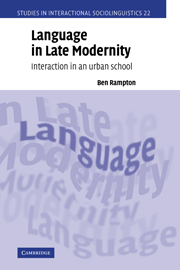Book contents
- Frontmatter
- Contents
- List of tables
- List of figures
- Acknowledgements
- Transcription conventions
- Part I Introduction
- Part II Urban classroom discourse
- Part III Performances of Deutsch
- Part IV The stylisation of social class
- 6 Language and class I: theoretical orientations
- 7 Language and class II: empirical preliminaries
- 8 Schooling, class and stylisation
- 9 Classed subjectivities in interaction
- Part V Methodological reflections
- References
- Index of names
- Subject index
6 - Language and class I: theoretical orientations
Published online by Cambridge University Press: 22 September 2009
- Frontmatter
- Contents
- List of tables
- List of figures
- Acknowledgements
- Transcription conventions
- Part I Introduction
- Part II Urban classroom discourse
- Part III Performances of Deutsch
- Part IV The stylisation of social class
- 6 Language and class I: theoretical orientations
- 7 Language and class II: empirical preliminaries
- 8 Schooling, class and stylisation
- 9 Classed subjectivities in interaction
- Part V Methodological reflections
- References
- Index of names
- Subject index
Summary
According to Abercrombie and Warde et al., historically in Britain social class has proved
an incisive analytic tool for understanding inequality, social division and political change. For much of the nineteenth and twentieth centuries, family background, main source of income, place of residence, cultural tastes and political affiliations were closely associated, and class position condensed information about these major aspects of social difference … Class linked together and summarised empirical description of many aspects of any individual' life.
(2000:145–146; see also Bradley 1996:46)They also show that although the twentieth century saw attempts to redistribute wealth and income, inequality and social division have persisted. Wealth has remained very concentrated – the wealthiest tenth of adults owned 50% of personal wealth in 1976, and still owned 49% in 1992 (provisional figure; Abercrombie and Warde et al. 2000:121) – and since the 1980s, poverty has grown from 9% of the population in Britain in 1979, to 24% in 1995/96 (2000:124). In addition, particularly in the higher and lower social categories, social mobility is relatively limited, and since 1972, “patterns of movement between class of origin and class of destination remain the same. Social mobility is not increasing” (2000:141).
At the same time, however, a number of commentators have suggested that although major inequalities of wealth and opportunity continue, a range of relatively recent economic, social and cultural changes have made social class itself a more difficult concept to use:
What is the working class today? What gender is it? What colour is …
- Type
- Chapter
- Information
- Language in Late ModernityInteraction in an Urban School, pp. 215 - 238Publisher: Cambridge University PressPrint publication year: 2006



